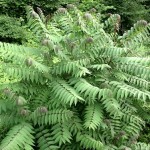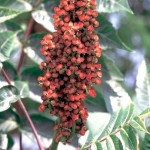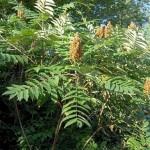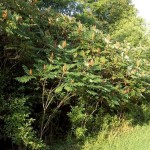Sumac Tree Bark – Rhus Glabra
|
Current Demand = Normal |
Parts Used: Root Bark & Tree Bark |
 |
 |
 |
 |
Family: Anacardiaceae
Common Names: fragrant sumac, aromatic sumac, skunkbush, sweet sumach…
Description:
The sumac tree is a perennial deciduous shrub that grows 2-6 feet tall with an irregular crown and is very dense. The branches have ascending tips with suckers. The leaves alternate with trifoliate ovate leaf shape and are shiny dark green. In the autumn, the leaves turn reddish-purple.
The flowers are yellow and bloom in late March. The fruit is a hairy, red drupe that matures in August. The twigs are slender, brown, finely fuzzy, with buds small and yellowish brown surrounded by a circular leaf scar.
Planting/Cultivation:
The plant prefers light, medium, and heavy soils that are well drained and in the sun. It requires dry or moist soil and can tolerate drought.
Propagation: leaf cuttings, herbaceous stem cuttings, seed sown direct outdoors in the fall.
Seeds: best sown in a cold frame as soon as it is ripe. Pre-soak the seed for 24 hours in hot water (starting at a temperature of 80 – 90c and allowing it to cool) prior to sowing in order to leach out any germination inhibitors.
When they are large enough to handle, prick the seedlings out into individual pots and grow them on in the greenhouse for their first winter. Plant them out into their permanent positions in late spring or early summer, after the last expected frosts. The plant is Dioecious, therefore male and female plants must be grown if seed is required.
Cuttings of half-ripe wood can be taken in July/August. They should be 10cm with a heel, and placed in a cold frame. Keep in the greenhouse during the winter and transplant in late spring or early summer to a permanent home.
Root cuttings can be taken in December and should be at least 4 cm in length. Pot vertically in a pot and keep in the greenhouse during the winter. Plant outside to a permanent home in late spring or early summer.
Harvesting/Drying:
Parts Used: tree bark and root bark
The root is harvested in the autumn and dried for later use. When dried the root is ¼ to 1 inch in diameter and appears in the marked place in pieces of 6 inches to 2 feet in length. The bark is a dark, rusty-brown color externally, and a pink or walnut color below the cork. The bark is about 1/8 inch thick and throughout the inner bark are little cavities that contain a transparent balsam. This gives off a turpentine odor when cut.
Attributes (Images)
By Richtid (Own work) [CC BY-SA 3.0 or GFDL], via Wikimedia Commons
By Homer Edward Price (Smooth SumacUploaded by Amada44) [CC BY 2.0], via Wikimedia Commons
 Root Buyer
Root Buyer